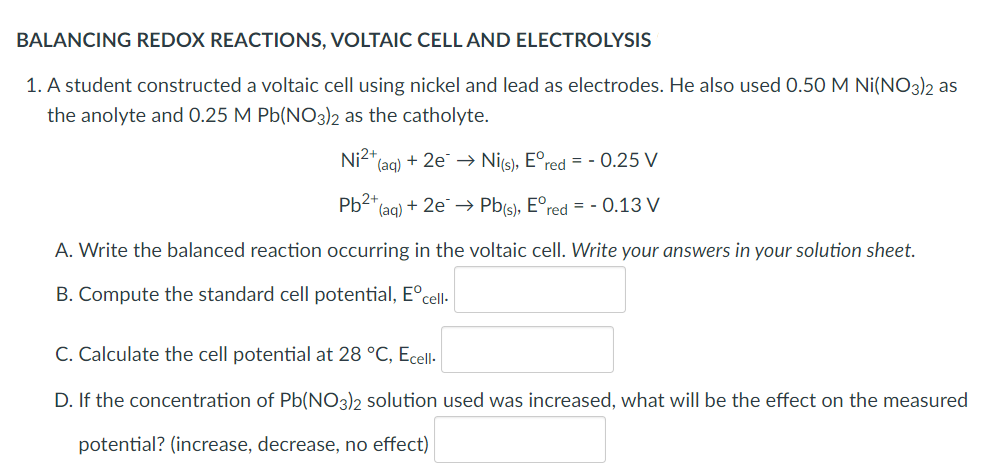BALANCING REDOX REACTIONS, VOLTAIC CELL AND ELECTROLYSIS 1. A student constructed a voltaic cell using nickel and lead as electrodes. He also used 0.50 M Ni(NO3)2 as the anolyte and 0.25 M Pb(NO3)2 as the catholyte. Ni²+ (aq) + 2e → Ni(s), Eºred = -0.25 V Pb2+ (aq) + 2e → Pb(s), Eºred = -0.13 V A. Write the balanced reaction occurring in the voltaic cell. Write your answers in your solution sheet. B. Compute the standard cell potential, Eºcell- C. Calculate the cell potential at 28 °C, Ecell- D. If the concentration of Pb(NO3)2 solution used was increased, what will be the effect on the measured potential? (increase, decrease, no effect)
BALANCING REDOX REACTIONS, VOLTAIC CELL AND ELECTROLYSIS 1. A student constructed a voltaic cell using nickel and lead as electrodes. He also used 0.50 M Ni(NO3)2 as the anolyte and 0.25 M Pb(NO3)2 as the catholyte. Ni²+ (aq) + 2e → Ni(s), Eºred = -0.25 V Pb2+ (aq) + 2e → Pb(s), Eºred = -0.13 V A. Write the balanced reaction occurring in the voltaic cell. Write your answers in your solution sheet. B. Compute the standard cell potential, Eºcell- C. Calculate the cell potential at 28 °C, Ecell- D. If the concentration of Pb(NO3)2 solution used was increased, what will be the effect on the measured potential? (increase, decrease, no effect)
Chemistry: The Molecular Science
5th Edition
ISBN:9781285199047
Author:John W. Moore, Conrad L. Stanitski
Publisher:John W. Moore, Conrad L. Stanitski
Chapter17: Electrochemistry And Its Applications
Section: Chapter Questions
Problem 92QRT
Related questions
Question
11. answer correctly or I will leave negative remarks.

Transcribed Image Text:BALANCING REDOX REACTIONS, VOLTAIC CELL AND ELECTROLYSIS
1. A student constructed a voltaic cell using nickel and lead as electrodes. He also used 0.50 M Ni(NO3)2 as
the anolyte and 0.25 M Pb(NO3)2 as the catholyte.
Ni²+ (aq) + 2e → Ni(s), Eºred = -0.25 V
Pb2+
(aq) + 2e → Pb(s), Eºred = -0.13 V
A. Write the balanced reaction occurring in the voltaic cell. Write your answers in your solution sheet.
B. Compute the standard cell potential, Eºcell-
C. Calculate the cell potential at 28 °C, Ecell.
D. If the concentration of Pb(NO3)2 solution used was increased, what will be the effect on the measured
potential? (increase, decrease, no effect)
Expert Solution
This question has been solved!
Explore an expertly crafted, step-by-step solution for a thorough understanding of key concepts.
Step by step
Solved in 3 steps with 3 images

Knowledge Booster
Learn more about
Need a deep-dive on the concept behind this application? Look no further. Learn more about this topic, chemistry and related others by exploring similar questions and additional content below.Recommended textbooks for you

Chemistry: The Molecular Science
Chemistry
ISBN:
9781285199047
Author:
John W. Moore, Conrad L. Stanitski
Publisher:
Cengage Learning

General Chemistry - Standalone book (MindTap Cour…
Chemistry
ISBN:
9781305580343
Author:
Steven D. Gammon, Ebbing, Darrell Ebbing, Steven D., Darrell; Gammon, Darrell Ebbing; Steven D. Gammon, Darrell D.; Gammon, Ebbing; Steven D. Gammon; Darrell
Publisher:
Cengage Learning

Chemistry & Chemical Reactivity
Chemistry
ISBN:
9781133949640
Author:
John C. Kotz, Paul M. Treichel, John Townsend, David Treichel
Publisher:
Cengage Learning

Chemistry: The Molecular Science
Chemistry
ISBN:
9781285199047
Author:
John W. Moore, Conrad L. Stanitski
Publisher:
Cengage Learning

General Chemistry - Standalone book (MindTap Cour…
Chemistry
ISBN:
9781305580343
Author:
Steven D. Gammon, Ebbing, Darrell Ebbing, Steven D., Darrell; Gammon, Darrell Ebbing; Steven D. Gammon, Darrell D.; Gammon, Ebbing; Steven D. Gammon; Darrell
Publisher:
Cengage Learning

Chemistry & Chemical Reactivity
Chemistry
ISBN:
9781133949640
Author:
John C. Kotz, Paul M. Treichel, John Townsend, David Treichel
Publisher:
Cengage Learning

Chemistry & Chemical Reactivity
Chemistry
ISBN:
9781337399074
Author:
John C. Kotz, Paul M. Treichel, John Townsend, David Treichel
Publisher:
Cengage Learning

Chemistry: An Atoms First Approach
Chemistry
ISBN:
9781305079243
Author:
Steven S. Zumdahl, Susan A. Zumdahl
Publisher:
Cengage Learning

Chemistry
Chemistry
ISBN:
9781305957404
Author:
Steven S. Zumdahl, Susan A. Zumdahl, Donald J. DeCoste
Publisher:
Cengage Learning